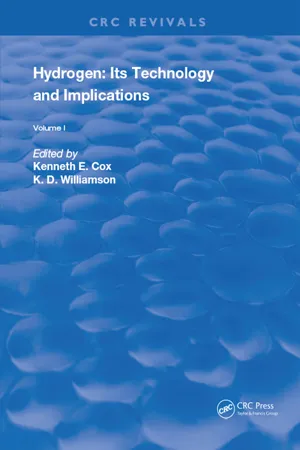![]()
Chapter 1
Water Electrolysis
Chapter 1
WATER ELECTROLYSIS
A. P. Fickett and Fritz R. Kalhammer
TABLE OF CONTENTS
1.1. | Introduction 1.1.1. Historical Background 1.1.2. Fundamentals of Water Electrolysis 1.1.2.1. Cell Reactions and Functional Components 1.1.2.2. Cell Voltage 1.1.2.3. Cell Current Density 1.1.2.4. Polarization Curves 1.1.2.5. Effects of Temperature on Water Electrolysis 1.1.2.6. Effects of Pressure on Water Electrolysis 1.1.2.7. Electrolysis Module or Stack |
1.2. | Generic Types of Water Electrolysis Systems 1.2.1. Unipolar Electrolyzer (Tank Type) 1.2.2. Bipolar Electrolyzer (Filter Press) |
1.3. | Electrolysis System Requirements 1.3.1. Power Conditioning and Control 1.3.2. Cooling Fluid Circulation and Control 1.3.3. Product Gas-water Removal, Purification, and Pressure Control 1.3.4. Electrolyte Monitoring and Control 1.3.4.1. Recirculating Electrolyte 1.3.4.2. Stationary Electrolyte 1.3.5. Instrumentation and Controls 1.3.6. Installation |
1.4. | Water Electrolysis Technologies 1.4.1. BBC Brown, Boveri, Co., Ltd 1.4.2. Constructors John Brown (CJB) Developments, Ltd 1.4.3. The Electrolyzer Corporation, Ltd 1.4.4. Lurgi Apparate-Technik GmbH 1.4.5. Oronzio De Nora 1.4.6. Teledyne Energy Systems 1.4.7. General Electric’s Solid Polymer Electrolyte Technology 1.4.8. Other Advanced Electrolyzer Concepts 1.4.9. Summary of Technology Status |
1.5. | Economics of Water Electrolysis 1.5.1. Factors Affecting Capital and Operating Costs 1.5.1.1. Capital Costs 1.5.1.2. Operating Costs 1.5.2. Relationship of Hydrogen Cost to Capital and Operating Costs |
1.6. | Projection and Impact of Technological Advances 1.6.1. Advanced Alkaline Technology 1.6.2. SPE Technology |
1.7. | Summary and Outlook |
References |
1.1 INTRODUCTION
Hydrogen production by the electrolytic decomposition of water is simple, reliable, clean, and based upon scientific principles that were demonstrated in the early 1800s. However, water electrolysis has not been used extensively for hydrogen production because of the high cost of electric energy compared to natural gas or naphtha. Only where substantial amounts of low-cost hydroelectric power are available have economics favored electrolytic hydrogen; large electrolysis plants have located only at such sites. Smaller-scale applications of water electrolysis have resulted when the reliability and convenience of the modular technology or the high purity of the product was more important to the user than energy economics alone. Whether the use of electrolytic hydrogen will expand significantly in the future will be determined primarily by the relative cost of electric energy, fossil fuels (including coal), and possibly of thermal energy if thermochemical water splitting becomes a reality.
Water electrolysis produces stoichiometric quantities of oxygen as well as hydrogen. If needed at the electrolysis site, oxygen at $17 to $32 per ton1 would result in a byproduct credit, reducing the hydrogen cost by $1 to $2 per 106 Btu. However, it is not economical to transport the oxygen even for short distances.1 Transportation requires liquefaction or compression and storage, offsetting any credits from the subsequent sale of byproduct oxygen.
Since the electrolysis plant design is essentially unaffected by the decision to use oxygen, and the use of oxygen on site will probably be uncommon, this chapter will concentrate exclusively on hydrogen as the product of water electrolysis. No credit for byproduct oxygen will be assumed in the economic analyses.
1.1.1. Historical Background
In 1800, Nicholson and Carlisle first produced hydrogen and oxygen by electrolysis of water. However, the first commercial water electrolyzer was not installed until 1902 by the Oerlikon Engineering Company.2 Oerlikon delivered more than 400 filter-press electrolyzers between 1902 and 1920. The first large (>104 m3/h) North American tank-type electrolyzer was located at Cominco Ltd., Trail, British Columbia in 1939.3 This plant was built originally to produce oxygen; it was later converted to supply hydrogen for fertilizer production.
A large filter-press electrolyzer was installed in Norway in 1927. This plant, which originally produced less than 104 m3/h, was upgraded in stages through 1965 to its present capacity of 90,000 m3/h.
Other large electrolyzers are located in India,4 Egypt,5 and Peru.6 All are located on major rivers and operate on inexpensive hydroelectric power. Table 1 summarizes features of these installations.
Until 1960, the developments in electrolyzers concentrated on improved safety, reliability, and user convenience. A major innovation was the design of an electrolyzer that could operate at pressure. This eliminated the need for an auxiliary compressor and enabled electrolyzer operation at elevated temperature. The first practical high-pressure electrolyzer was the 1948 Zdansky-Lonza design licensed by Lurgi. A plant of this design and capable of producing 5000 m3/h at 30 kg/cm2 was installed in Cuzco, Peru in 1958.6
In the late 1950s and early 1960s, interest developed in water electrolysis as a source of oxygen for life support in submarines and spacecraft. In these applications, light weight and low volume rather than cost became the primary criteria. During the same period, the transfer of elements of new fuel-cell technologies to electrolysis helped achieve improvements in electrolyzer performance and efficiency. Several advanced electrolyzer concepts were developed for life support applications. The more notable of these are the General Electric SPE technology, based on a solid polymer electrolyte, and the Teledyne technology, based on a potassium hydroxide electrolyte. The General Electric unit is not anticipated to be commercially available on a larg...
